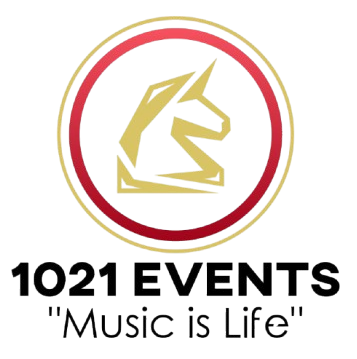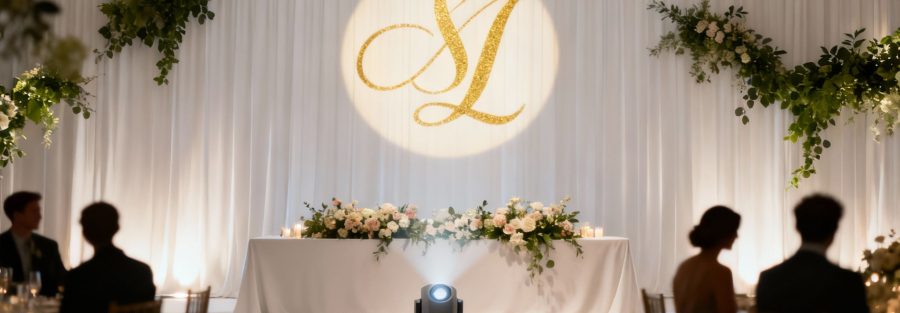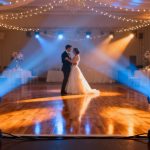Ever seen a couple's initials shining bright on the dance floor or a wall at a wedding? That’s a monogram projection. It’s a personalized lighting effect that beams your names, initials, or a custom design right onto a surface at your venue.
Think of it as a dynamic piece of decor. Instead of just hanging something on the wall, you're using light to transform a space. It’s a simple touch that makes a huge impact, turning a plain wall or an empty dance floor into a seriously stunning, photo-ready focal point.
The Power Of Personalized Lighting
A wedding monogram projection is basically your personal brand for the day, lit up in style. It's a modern, high-impact way to claim your venue and make it feel completely, uniquely yours. Unlike static decorations that just sit there, this lighting element adds a layer of ambiance and sophistication. It can shift with the mood of your event, from a soft, romantic glow during dinner to a vibrant centerpiece when the party gets started.
This isn't just a niche trend; it's part of a huge move toward highly customized weddings. Couples want their day to tell their story, and the numbers back it up. The wedding services market hit a staggering USD 899.64 billion in 2024, with decorative services being one of the fastest-growing areas. This just shows how much couples value visual elements that make their celebration one-of-a-kind.
What Is A Gobo, Anyway?
So, how does this magic happen? It all comes down to a little stencil called a gobo. A gobo is a small disc, usually made of metal or glass, with your custom design etched into it.
A specialized projector then shines a powerful beam of light through that stencil, and voilà—your design is projected onto your chosen surface. It’s a pretty straightforward concept, but the visual payoff is massive. You get a crisp, clear image that perfectly captures your style. Digging into the basics of gobo lighting can really help you articulate your vision when you talk to your vendors.
Choosing The Best Location
Where you put your monogram projection is everything. You want it somewhere it will be seen, feel meaningful, and look amazing in all your photos. There are a few tried-and-true spots that always work, each with a different vibe.
- The Dance Floor: This is the fan favorite for a reason. It creates a spectacular centerpiece for your first dance and looks incredible in party photos later on.
- Behind the Head Table: Placing it here frames you and your partner beautifully. It serves as a perfect backdrop for speeches, toasts, and all those dinner-time candids.
- Venue Exterior: Want to make a grand entrance? Projecting your monogram on an outside wall greets your guests with a "wow" moment before they even step inside.
This infographic breaks down the visibility of these popular spots.
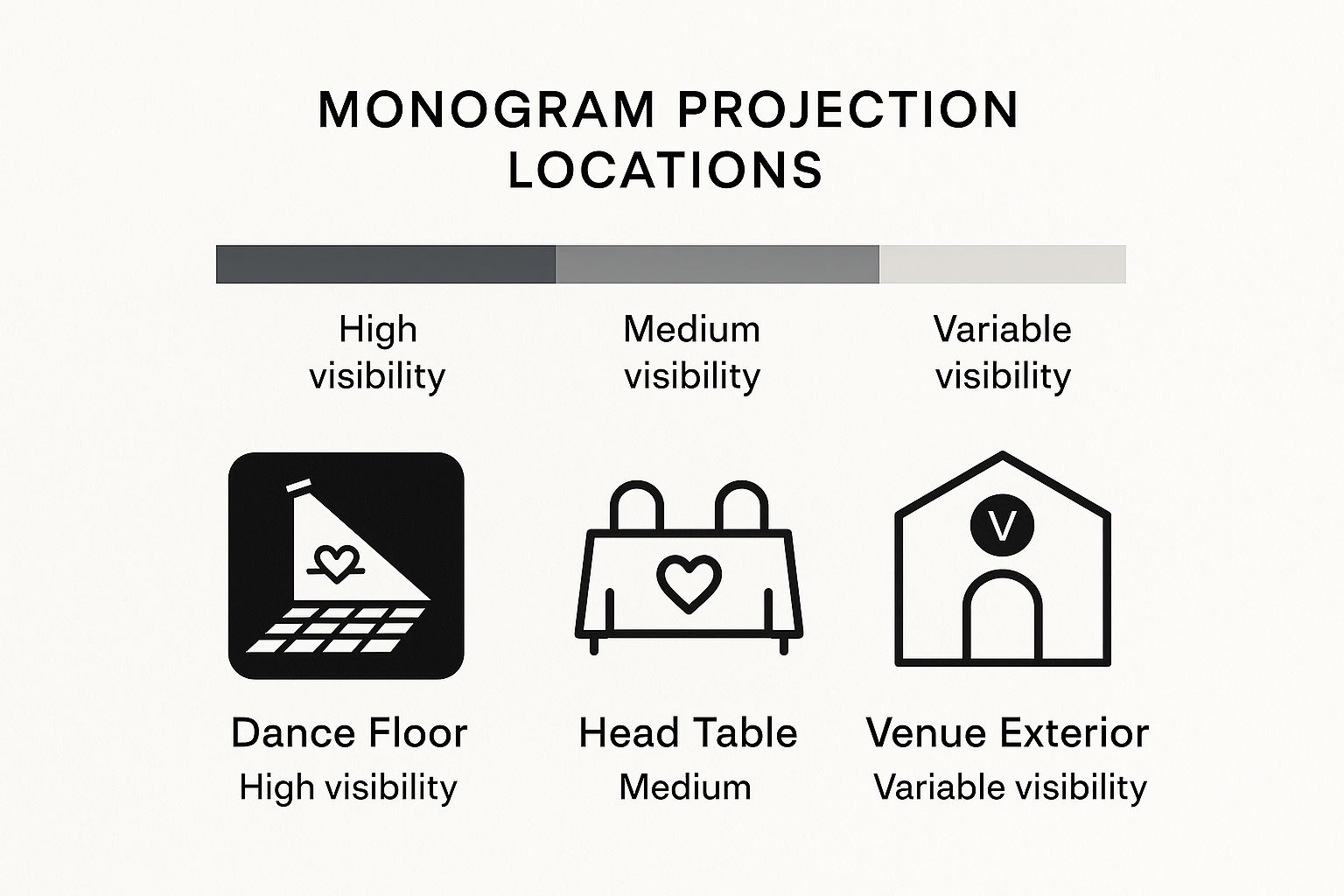
As you can see, the dance floor really takes the cake for high visibility, making sure your custom design is a central part of the celebration all night long.
Crafting Your Perfect Monogram Design
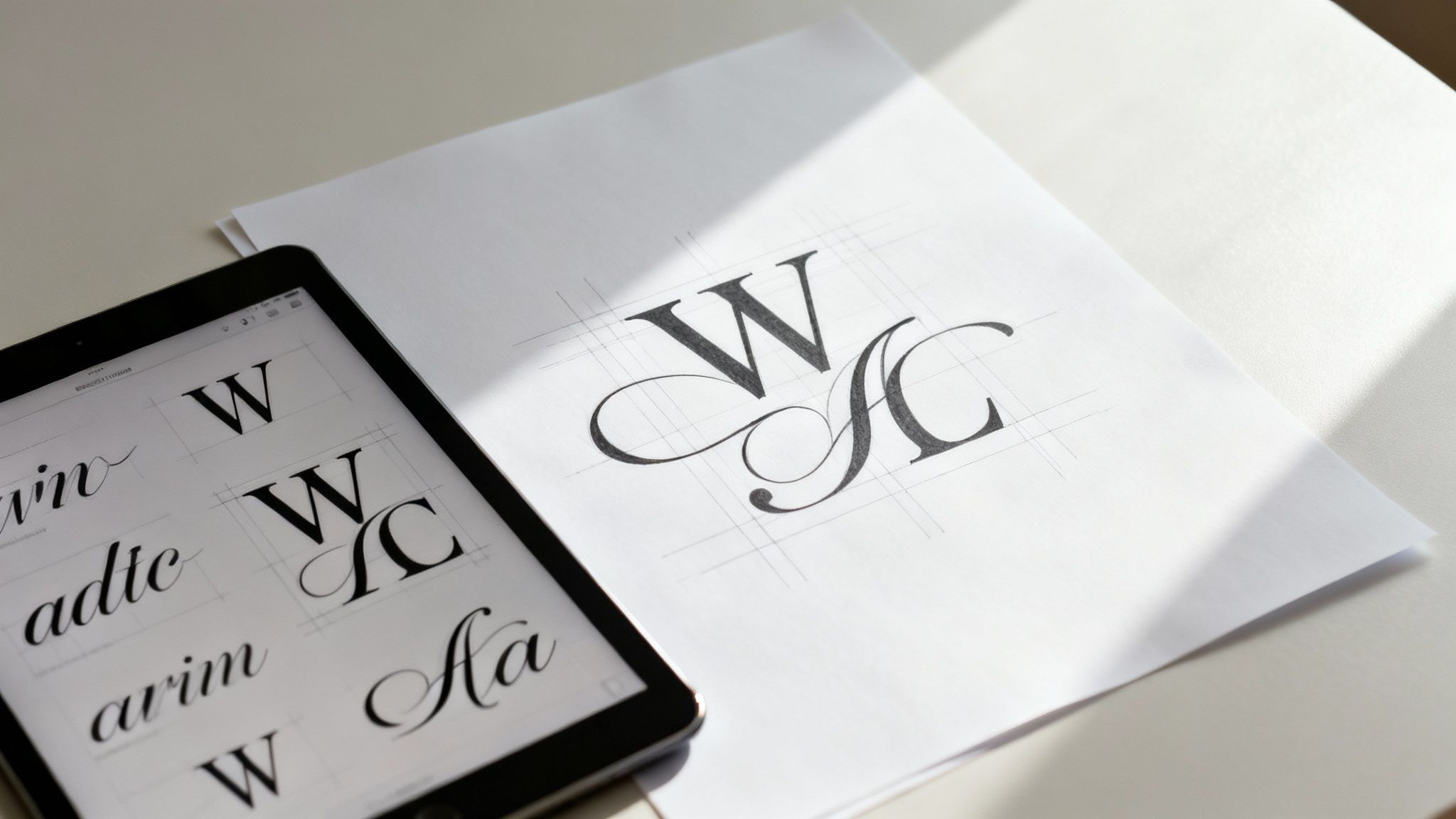
Alright, this is where the fun really begins. Your wedding monogram isn't just a fancy light on a wall; it’s the signature of your big day. Think of it as a chance to create something that feels uniquely you.
Let’s move past the standard initials-and-a-date for a second. What’s your story? A great monogram captures the vibe of your relationship. Maybe it’s a sleek, modern font for a city-chic wedding or an ornate, timeless script that speaks to a classic romance.
This single design element becomes a huge part of your event's identity. It’s more than just decor—it’s a key piece of unforgettable branding for events that pulls everything together, making your celebration feel cohesive and intentional from the moment your guests walk in.
Weaving Your Story into the Design
The most memorable monograms tell a little story. This is your chance to add small, meaningful symbols that are special to you as a couple.
Did you meet in a city with a famous skyline? A subtle silhouette could be a beautiful, personal touch. Maybe you both love hiking? A simple mountain range or a delicate leaf motif can add a layer that’s all your own. It’s these little details that turn your wedding monogram projection into a real conversation starter.
When it comes to fonts, think about the overall mood you're going for.
- Serif Fonts: Think Times New Roman. These are your classics—they feel traditional, elegant, and super romantic.
- Sans-Serif Fonts: Like Arial or Helvetica. These give off a clean, modern, and minimalist vibe.
- Script Fonts: These look like handwriting and can range from formal and flowing to something much more playful and casual.
Key Takeaway: Whatever you choose, it has to be readable from across the room. A font that’s too thin or a design that’s overly complicated might look stunning up close, but it can turn into a blurry mess when projected. My advice? Always go for bold, clear lines.
DIY Design versus a Professional Touch
One of the first questions couples ask is whether they should design the monogram themselves or hire a pro. Honestly, there's no wrong answer. It really just boils down to your budget, how much time you have, and how confident you feel in your creative skills.
Going the DIY route with a tool like Canva or an Etsy template is a great way to save money and keep total control. If you have a clear vision and actually enjoy the design process, this is a fantastic option. You can play around with different styles until it feels just right.
On the flip side, a professional graphic designer brings a ton of expertise you just can't fake. They know the technical side of things, like making sure your file is a high-resolution vector format (.AI or .EPS) that your lighting vendor will need. Plus, a good designer can spark creative ideas you might never have thought of. If you're feeling a bit stuck, checking out some great examples of a monogram for weddings can definitely get the ideas flowing.
To help you figure out which path is for you, here’s a quick comparison.
DIY Design Tools vs Hiring A Professional
| Consideration | DIY Design (Canva, Etsy Template) | Professional Designer |
|---|---|---|
| Cost | Low to moderate, often under $50. | Higher investment, typically $100+. |
| Time | Requires your own time for designing. | Saves you time; handles all design work. |
| Expertise | You are the creative director. | Provides professional insight and polish. |
| File Format | You must ensure correct export. | Delivers a ready-to-use professional file. |
Ultimately, whether you design it yourself or bring in an expert, the goal is the same: to create a beautiful, personal symbol of your union that will light up your celebration.
Finding The Right Equipment And Vendor
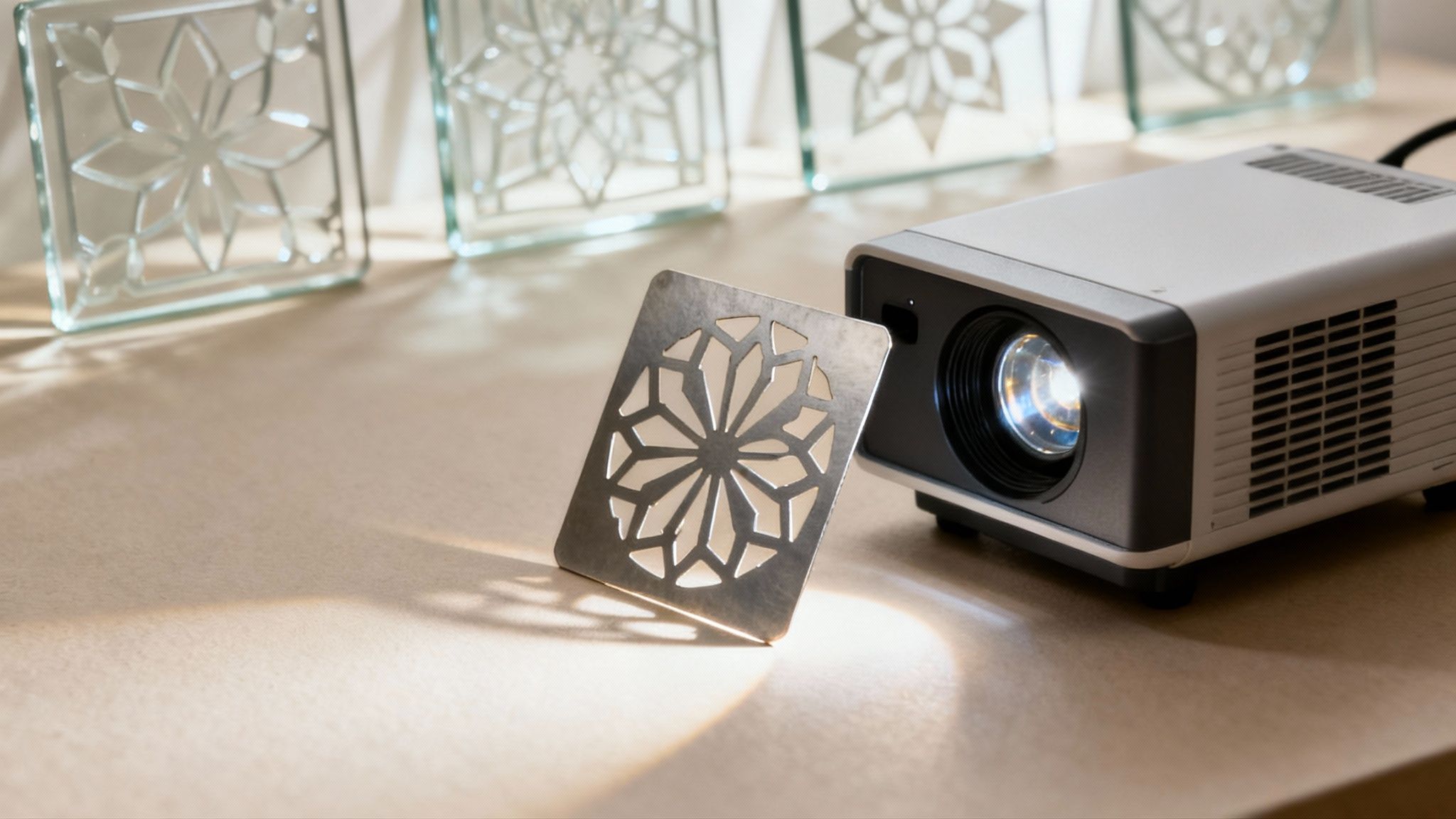
Alright, you’ve got a gorgeous monogram design. Now for the fun part: making it shine. This is where we get into the tech, but don't let that intimidate you. The secret to a jaw-dropping monogram projection is simply having the right gear and a vendor who actually knows their stuff.
The magic happens with a small, custom-made stencil called a gobo. Picture a tiny slide for a projector, but instead of a vacation photo, it has your unique design cut or etched into it. A seriously bright light shines through this gobo, and voilà—your monogram is splashed across the dance floor, a feature wall, or even the ceiling.
Getting to Know Your Gobos
Gobos aren't a one-size-fits-all deal. They usually come in two flavors, and your choice will impact both the final look and your budget.
-
Metal Gobos: This is the go-to for most people. They're budget-friendly and get the job done for simpler designs with bold text or basic shapes. A laser literally cuts your design into a thin steel disc. The only catch? Any letter with a closed loop (like an 'O' or a 'B') needs a tiny connector piece to hold the center in place. It's subtle, but it's there.
-
Glass Gobos: If your design is intricate or has fine details, you’ll want to spring for glass. Your design is etched onto a special piece of high-temperature glass, which means no connecting pieces are needed. This allows for incredibly sharp, clean lines, grayscale images, or even full-color projections. They do cost more, but the polished, high-end result is often worth every penny.
Choosing The Right Pro For The Job
You'll find monogram projection services offered by all sorts of event pros, from dedicated lighting companies to mobile DJs who bundle it into their packages. Finding a great partner is what makes the difference between "cool" and "unforgettable."
The wedding industry is shifting fast, with the full-service planner market projected to hit USD 519.62 billion by 2032. This just goes to show how much couples value having a seasoned expert handle every last detail. For vendors looking to connect with these planners, understanding their online presence through guides on website strategies for wedding planners is becoming essential.
When you're interviewing potential vendors, ask detailed questions. A true professional will be excited to talk shop and proudly show you their past work. Don't settle for vague answers.
Here’s what you absolutely need to ask before signing a contract:
- Do you handle the gobo creation from start to finish? You want to know if they manage the whole process or if you'll have to order the gobo yourself. An all-in-one service is almost always easier.
- Tell me about your projector. Ask about its brightness (lumens). A dim projector in a bright, large room is a recipe for a washed-out monogram.
- Can I see pictures of your work at a real wedding? This is a must. A stock photo doesn't tell you anything. You need to see how their projections look in a live event setting to gauge the quality.
- What exactly does your price include? Get it all in writing. Does the quote cover the custom gobo, projector, stand, setup, and breakdown? No one likes surprise fees.
Companies that focus on event lighting rentals often provide complete packages that make the whole process completely seamless, which is a huge stress reliever.
So, Where Should We Put This Thing? Finding the Perfect Spot for Your Monogram
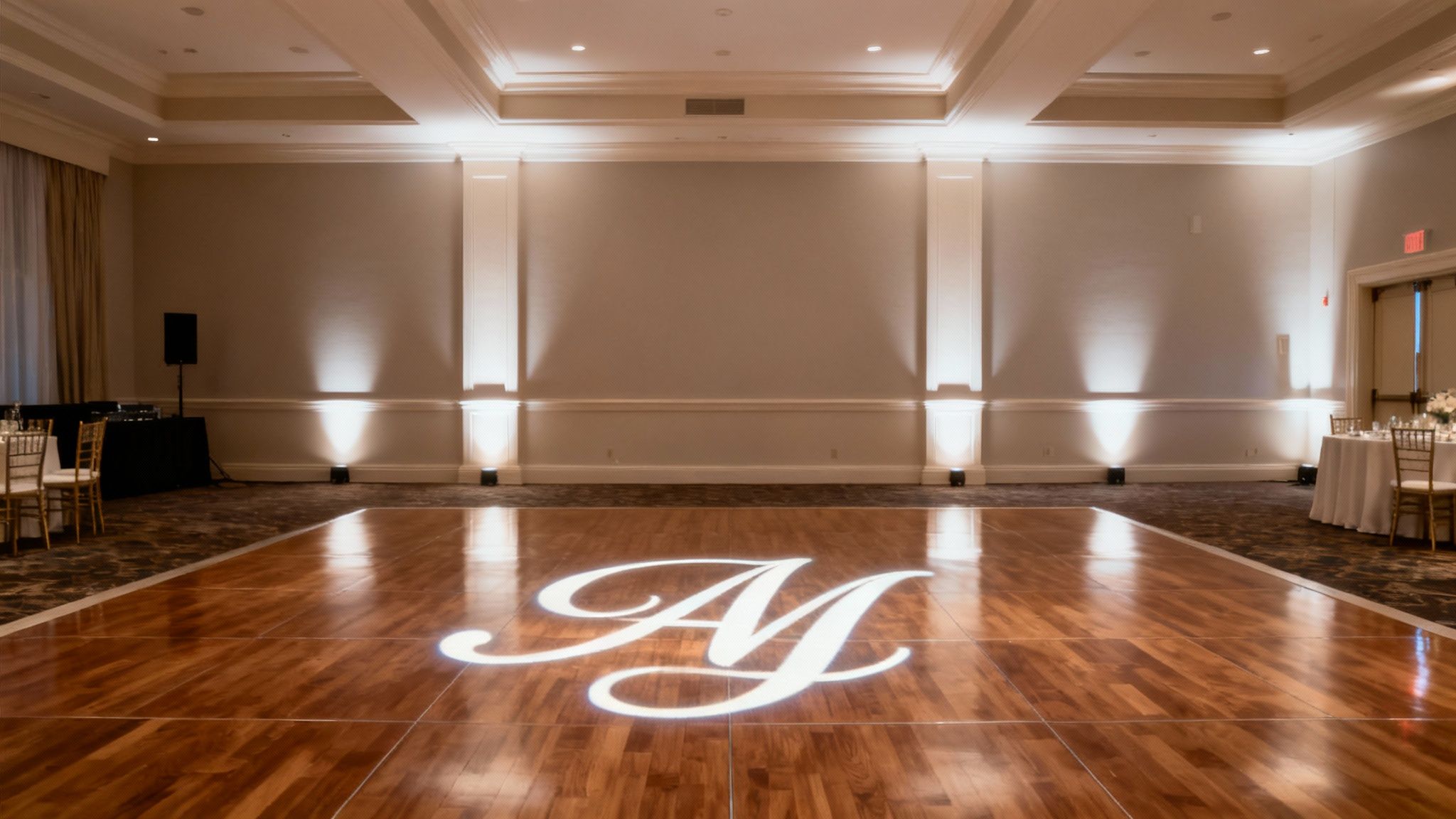
Alright, you've got the perfect monogram design. Now for the million-dollar question: where do you project it? This decision is just as crucial as the design itself. The right placement can transform your monogram into a breathtaking centerpiece, but the wrong one can leave it feeling lost or like a last-minute addition.
Think of it like hanging a prized piece of art. You wouldn't stick a masterpiece in a dark, cluttered corner, right? The same goes for your wedding monogram projection. We're looking for a spot that's impossible to miss, looks amazing in photos, and won't get blocked by a rogue server or your uncle's epic dance moves.
The Best Places to Make a Statement
Let’s run through the most popular (and effective) spots to show off your custom design. Each location has its own vibe, so think about what works best for the flow and feel of your reception.
-
Front and Center on the Dance Floor: This is the classic for a reason. It creates a truly magical focal point for your grand entrance and first dance. As the night unfolds, it becomes part of the party, showing up in all those fun, candid photos of your guests. The only real trade-off? Once the dance floor is packed, your monogram will be underfoot.
-
The Wall Behind the Head Table: This is a seriously sophisticated choice. It creates a stunning, ever-present backdrop that frames you both during dinner, toasts, and all those heartfelt speeches. It guarantees your monogram gets tons of visibility without being interrupted by foot traffic.
-
Above the Cake or Dessert Table: I love this idea. It’s a brilliant way to spotlight another key element of your reception. It ties everything together, linking your personalized lighting directly to a sweet, celebratory moment like the cake cutting.
My Two Cents: Loop in your photographer on this! Give them a heads-up on where the projection will be. They can plan some truly incredible shots around it and give you advice on how the light will play with their camera flash. You want those pictures to be perfect.
What to Consider Before You Decide
Picking the perfect spot is about more than just pointing and shooting. You’ve got to play with the hand your venue deals you—its layout, its lighting, and its quirks—to make sure your monogram looks sharp and vibrant all night.
Before you set anything in stone, think about these key factors:
- The Surface Itself: A smooth, light-colored wall with a matte finish is the gold standard. Rough textures like exposed brick or dark wood paneling can warp the image or suck the life out of it, making it look dim.
- The Room's Lighting: How bright is the space? A high-quality projector can stand up to some ambient light, but your monogram will always look its best and have more "pop" in a darker area. This is where a good lighting plan, including learning all about uplighting at your wedding reception, can create the perfect moody atmosphere.
- Guest Foot Traffic: Are people going to be constantly walking in front of the projection, casting shadows and breaking the illusion? A spot with less traffic, like a high wall or a dedicated photo-op corner, is usually a safer bet.
Common Projection Mistakes You Can Easily Avoid
https://www.youtube.com/embed/D44LJUKIUXI
A wedding monogram projection should be an absolute showstopper. But I've seen a few simple missteps turn a potential “wow” moment into a “what’s that?” situation. The good news? A little bit of planning goes a long way, and the most common mistakes are surprisingly easy to sidestep once you know what to look for.
The biggest pitfall is hands-down choosing a design that’s way too intricate. A monogram with super-thin lines, delicate swirls, or tiny text might look beautiful on an invitation, but it often becomes a blurry, unreadable mess when projected across a large room.
You're aiming for a crisp, clean image that guests can appreciate from a distance. Think bold and clear.
Overlooking the Projection Surface
Another frequent error is completely ignoring the surface where the monogram will land. Trust me, not all walls are created equal. A dark, textured surface like exposed brick or busy wallpaper will just swallow the light and distort your design. The result is often dim, warped, and disappointing.
To get that sharp, vibrant look you see in photos, you need a smooth, light-colored, and preferably matte surface. Think of it as a movie screen—the cleaner the canvas, the better the picture. This simple consideration is the key to making your wedding monogram projection truly pop.
Expert Tip: Always do a site visit or, at the very least, ask your vendor for photos of potential projection spots at your venue. This little bit of prep work ensures you find the perfect canvas and avoid any day-of letdowns.
Getting the Placement and Angle Wrong
Okay, let's talk about placement. If the projector is set up in the wrong spot, you can end up with a distorted, trapezoid-shaped image. This is known as the "keystone effect," and it happens when the projector is at too sharp an angle to the wall. Modern projectors have features to correct this, but it’s always best to position the unit as straight-on and level as you possibly can.
This detail really matters when you're going for a cohesive, personalized wedding aesthetic. The demand for these kinds of details is booming—the printed wedding merchandise market is expected to grow to $19.94 billion by 2032. A crooked or blurry monogram can easily disrupt that carefully curated theme you've worked so hard on. You can discover more insights about wedding personalization trends on fortunebusinessinsights.com.
Forgetting to loop in your other vendors is the final piece of this puzzle. It's absolutely crucial to chat with your photographer about the projection’s placement and brightness so they can get the best shots.
Your lighting technician also needs to be in the loop to make sure the monogram doesn't get completely washed out by other lights. It's all about creating a layered, intentional look. If you're interested, our guide on how wedding dance floor lighting can show you how these elements can work together.
By sidestepping these common errors, your monogram is guaranteed to look spectacular all night long.
Got Questions About Your Wedding Monogram? Let's Clear Them Up.
So you're thinking about a wedding monogram projection? Awesome choice. It's one of those details that really wows your guests. But I get it—it also brings up a bunch of practical questions. Let's walk through some of the most common things couples ask me.
How Much Should We Budget For a Monogram Projection?
This is usually the first question, and the honest answer is: it varies. You can expect the cost to land somewhere between $150 and over $500. It really boils down to a few key things.
The final price tag depends on what you're actually getting. Are you just renting the projector itself, or are you paying for a full-service package that includes design, setup, and teardown? The type of "gobo" (that's the little disc with your design on it) also matters. A detailed glass gobo will be more of an investment than a standard metal one. Also, think about who is providing it. A specialized lighting company's pricing might look different from a DJ who offers it as an add-on.
My Two Cents: Get an itemized quote. It's the only way to avoid surprise fees. Make sure it lists everything from the gobo creation to the labor for setup so you know exactly where your money is going.
Can We Project the Monogram Just Anywhere?
Not quite. For that crisp, magazine-worthy look, your "canvas" is key. The best spots are always flat, smooth, and light-colored surfaces. Think of a clean, light-colored wall or right in the center of an empty dance floor.
Surfaces with a lot of texture, like a brick wall or busy wallpaper, can really distort the image and make it look messy. And dark walls? They just soak up the light, leaving your beautiful monogram looking faint and hard to read. I always recommend doing a walkthrough with your venue coordinator or lighting expert to pinpoint the perfect placement before the big day.
What Kind of File Do I Need for My Design?
This one’s a big deal on the technical side. Your lighting company will almost certainly ask for a high-resolution vector file. The most common formats are .AI (Adobe Illustrator) or .EPS.
So, what's a vector file? Unlike a regular image file (like a JPG), which is made of pixels, a vector is made of mathematical lines and curves. This means you can blow it up to the size of a wall without it ever getting blurry or pixelated. That scalability is absolutely essential for a sharp, clear projection that looks amazing from every corner of the room.
If you hired a graphic designer for your monogram, they'll know exactly what to send over. If you're designing it yourself, just double-check that your software can export in one of those formats. It’s a small detail that has a huge impact on the final look.
Ready to see your names in lights? The team at 1021 Events lives for creating those unforgettable, personalized moments. We'll handle all the lighting details so you can just enjoy the party. Explore our custom lighting and event services to get started!
